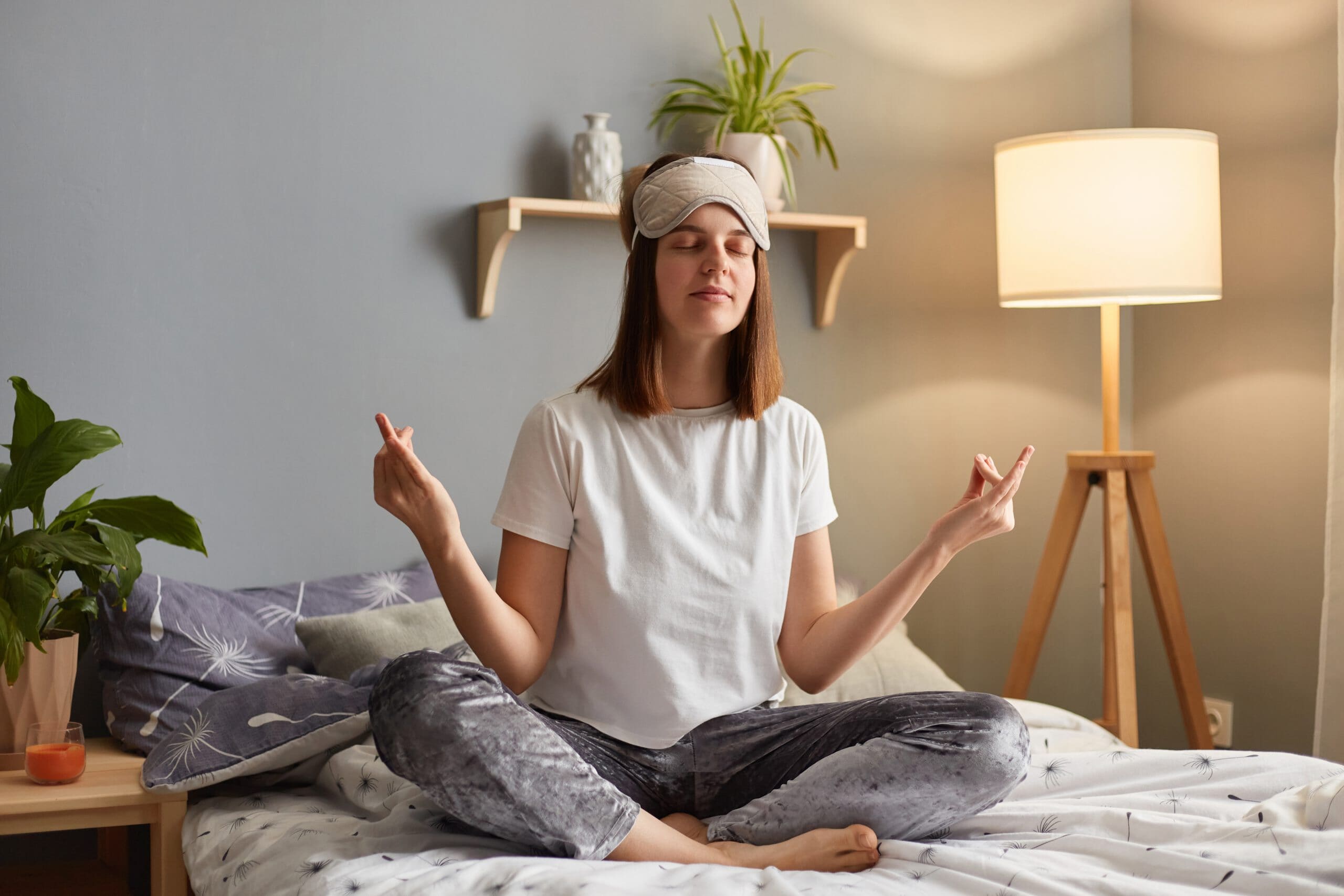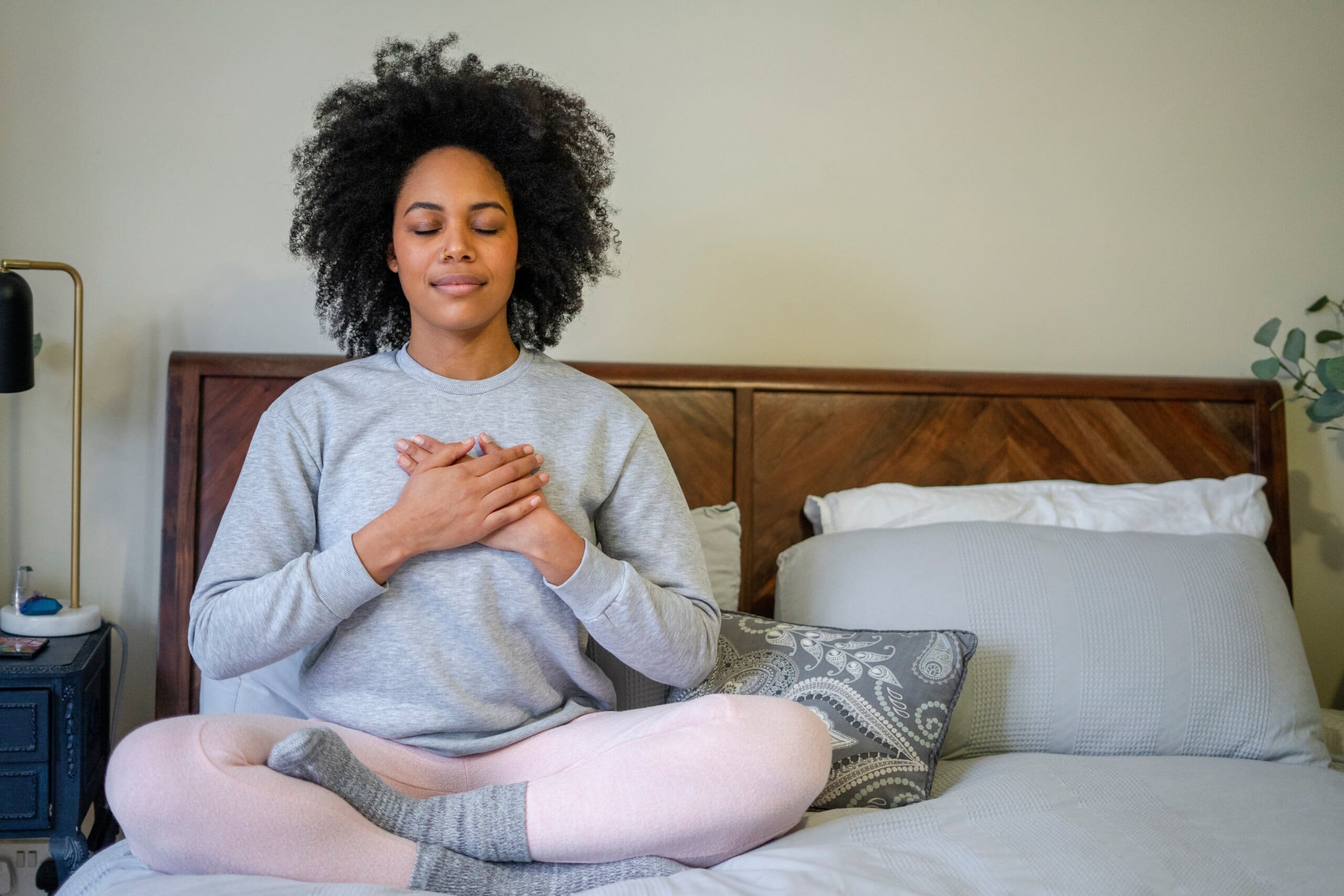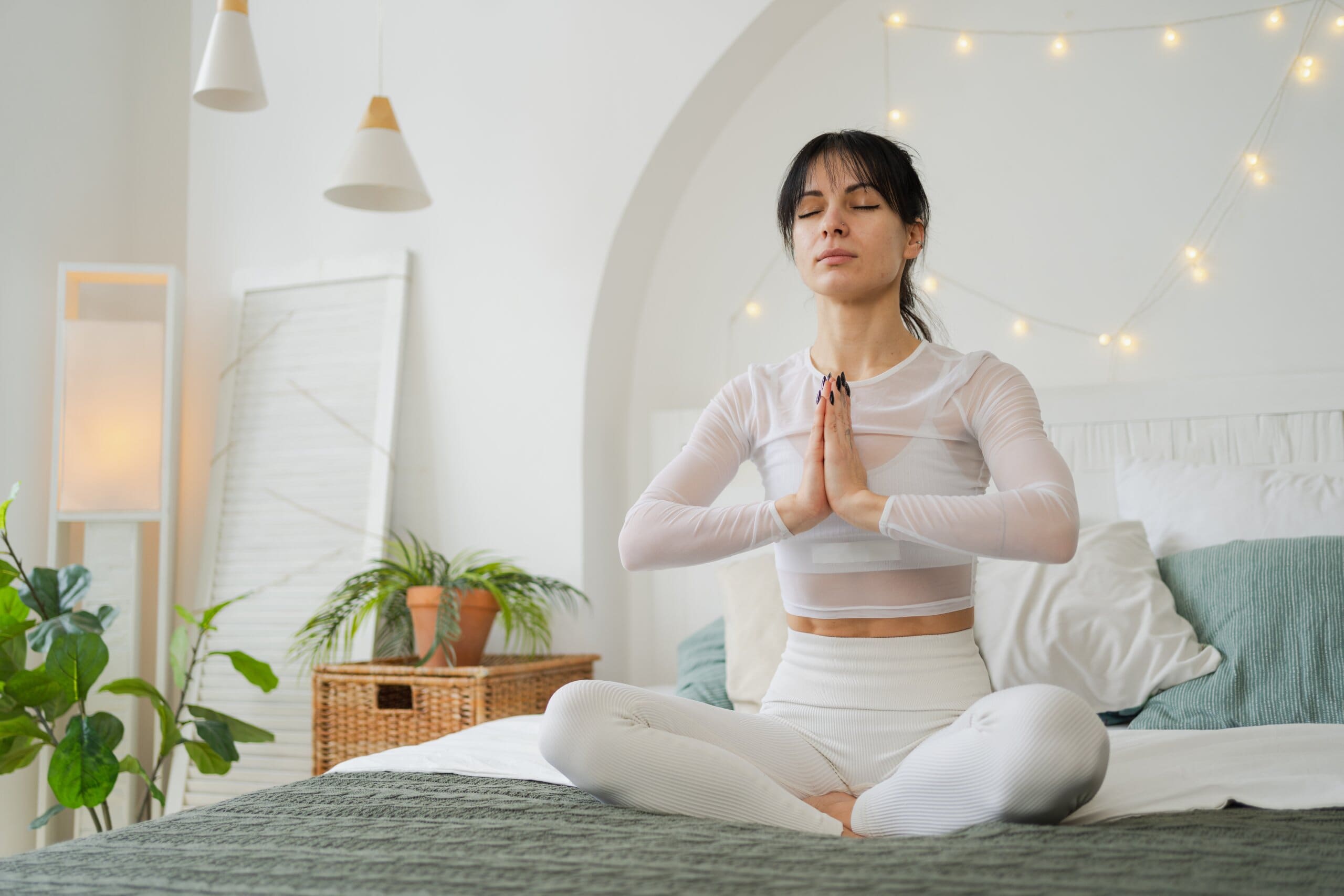For many of us, life in the modern day has never felt more stressful! From the increasing demands of our ever-busy jobs to handling personal finances and finding time for friends and family, it’s little wonder many of us feel like we’re constantly struggling with the effects of sleep deprivation and sticking to a regular sleep schedule.
Simply put, even if we don’t think of ourselves as naturally anxious, the constant whirlwind of life can be challenging to escape from when bedtime rolls around and our heads hit the pillow at the end of the day.
So, if your brain’s always buzzing by the time you take yourself off to bed, you might be wondering if something calming, such as meditating before sleep, could be worth a go – if only to help you settle your nerves so you can get some much-needed rest.
Well, outside of sleep, the benefits of meditation are well-known, but no longer is this practice just the sole preserve of Buddhist monks and wellness gurus. In fact, meditating before sleep is something we can all learn to do well with a little bit of practice!
But what is sleep meditation, and what sort of benefits are associated with it? Read on to learn more about how to meditate to sleep, and the top meditative sleep techniques you can try at home tonight.
Who knows, perhaps your body, mind, and mental health will thank you for it!

What is sleep meditation?
Unlike regular forms of meditation, which focus on encouraging alertness and awareness throughout the day, sleep meditation looks at preparing your mind and body for rest through physical and mental relaxation techniques, such as guided breathing and other common well-being practices.
As we noted above, for many of us, lying down and going straight to sleep just isn’t something we’re all capable of. However, with well-practised sleep meditation, you can help speed up the process so that you’re not left tossing and turning into the early hours of the morning.
What are the benefits of meditation before sleep?
Just as meditation can help to settle and realign our mind when we’re stressed out on a busy day, the same is true for anyone looking to soothe those rushing thoughts going through their head before bed.
Indeed, the main benefit of meditation before sleep is the calming sense of serenity and peace that it can create in your body, which naturally makes you feel more relaxed and can go a long way towards curbing the various symptoms of sleep anxiety.
But why does meditating before sleep cause this soothing effect? Well, according to various studies, meditation increases the production of both serotonin and melatonin, two hormones that are intertwined with sleep and activate the parts of your brain related to the sleep processes.
Not only that, but meditation has been shown to lower your heart rate, decrease blood pressure, and relieve anxiety, all of which will focus your mind towards settling and making you mentally primed for sleep.
In other words, when done right, meditation can activate your body’s sleep process.
Should you meditate before bed?
Given the various benefits we outlined above around meditation and sleep, there’s a strong case to be made for doing your evening meditation right before bed. However, the perfect time for meditation is a subjective matter, and you might, for example, find that you benefit more from this sort of activity by doing it right after you get in from work.
But, with that being said, for anyone on a tight schedule or with busy evenings, it’s often most convenient to meditate right before bed, and doing so when you’re just starting out is an easy way to turn this wellness practice into a habit.

Meditating before sleep: How to get started
Although embracing meditation for relaxation can be a powerful tool for getting to sleep quickly, it can be tricky to master, especially if you’ve never tried anything meditative before.
That’s why the very first thing we recommend everyone do before trying any form of sleep meditation is to create an effective nighttime sleep routine, as this will ensure the right foundations are in place for you to succeed.
From here, you should then focus on getting the following basics right before moving on to the core sleep meditation techniques we’ve outlined further down, or even more advanced meditation practices like sound bathing.
1. Make sure your sleeping environment is comfortable
First things first, before you make a start on any meditative practises, it’s essential that your sleeping environment is as comfortable as possible. After all, you’ll be lying still for quite some time, so you don’t want to end up getting too cold or uncomfortable.
If you find your duvet rather heavy, consider putting a sheet over your body instead, or wearing your dressing gown, as a sub-optimal body temperature may cause you to tense up and lose focus.
Alongside this, a comfortable mattress that’s got all the essentials in terms of postural support is a must, as is paying attention to things like room temperature and light levels. You might also want to consider banning partners and noisy kids from your rest and relaxation zone during meditation, at least until you’ve mastered the basics.
And, finally, it's true that what you wear and smell like will make a world of difference to your bedroom's zen-like sense of calm, so scratchy PJs and stale bedlinen are both huge no-nos!
2. Finding the perfect position
While you can theoretically meditate in any position, for sleep meditation in particular, our experts have found that lying flat on your back is the best way to create a sense of balance and harmony.
This is because lying on your back is by far the easiest posture to maintain for an extended period of time, and we found it to be less distracting than being on your side, front, or curled up in a ball. And as an added bonus, it also makes it easier to do some of the more advanced meditation techniques we’ll be touching on later.
3. Focus on slow and simple breathing
Lastly, regardless of how successful you are in your initial sleep meditation attempts, the one core thing you should focus on maintaining while you meditate is a slow and steady breathing rhythm.
Even if you don’t get as far as full-on meditation to get to sleep, maintaining calm, slow, and deep breathing can have a wondrous effect on your body and mind, and it’s one of the simplest preludes to prime your mind for a proper meditative session.
How to meditate before bed: Techniques to try
Ready to get comfy, dive under your freshly washed duvet, and try your first attempt at sleep meditation? Well, shut your eyes, steady your breathing, and give one of the different techniques we’ve outlined below a go:
1. 4-7-8 breathing
For your first attempt at sleep meditation, it’s best to avoid anything complex and stick to some simple breathing techniques to help you sleep, such as the 4-7-8 breathing routine.
To start, place your tongue against the roof of your mouth, then inhale through your nose for four seconds, hold it for seven seconds, and exhale out your mouth for eight seconds – finishing like you’re blowing out a candle. Keep going for as long as you like and enjoy the soothing sensation that such a breathing technique can bring.
2. Body talk
One of the most popular meditation techniques for adding the sense of calm needed to facilitate sleep is identifying areas of stress or tension within the body. The idea here is to zone in on knotted muscles and force your mind to make them relax, becoming aware of and in tune with the difference it makes as you go.
Starting with the top of your head, work your way down to the tips of your fingers to the ends of your toes, inch by inch, centimetre by centimetre, limb by limb, digit by digit, until you’ve covered the whole of your body.
It can be an odd sensation at first, seeing as we rarely take time to focus on our bodies in such a dedicated and systematic way, but you may be surprised how therapeutic it feels once your body starts to unwind.
3. Tensing and relaxing
An addition you can make to the body talk method, some people find that slowly tensing and relaxing each and every part of their body in turn can help to amply the associated relaxing effects.
For example, try scrunching up your hands as hard as you possibly can for a count of five while taking a really deep breath, then expelling all the pent-up energy in a powerful push, exhaling every single last drop of air from your lungs at the same time. You might be surprised at the relief it brings!
4. Mental calmness
This approach to meditation to get to sleep is all about preventing your inner monologue from getting hold of your headspace and filling it with unhelpful negative thoughts at bedtime. Instead, picture a safe, happy, relaxed place, and encourage your senses to live or re-live all that’s good about being there.
Whether it’s an exotic holiday you went on, a delightful meal you had, or a spa treatment you’re looking forward to, whatever memory or experience you choose, take the time to become aware of how it looks, how it sounds, how it smells, how it tastes, and (most importantly) how it feels in the here and now.
From here, you want to find a bag or box within the scene, then calmly put any negative thoughts inside it as and when they come along. Accompany this with phrases such as ‘I do not need to deal with this now’ and ‘this can wait until later’, as a means of prompting your brain to put such problems to the back of your mind.
Then, when you’ve finally found stillness within your mind, bury the bag or box in the ground, or shut it firmly away in a cupboard. Such a method like this can be tricky to start at first, but if you can master it, we’re sure you’ll find it comforting (just remember to give such boxed-up problems the time and attention they need when you can).
5. Visualisation
Finally, our last technique for meditation to get to sleep is all about training your mind to take your body to another level, delivering an unrivalled sense of tranquillity and wellness in the process – if you ever wanted to experience a deeper mind-body connection or the power of positive thinking, this is it!
To start with, picture a ball of warm, pure, energised light hovering above your forehead. From here, focus on how pleasant, regenerative, and restorative it feels. Give yourself plenty of time to embrace this sensation and allow it to thrive.
Next, imagine this pulsating ball of light becoming a liquid and travelling slowly down from your head and spreading over the entirety of your body, engulfing you in its warmth. Hold these thoughts for as long as you can, allowing yourself the time and mental space needed to absorb how the sensation makes you feel, before slowly releasing it.
Again, this is quite a complex meditation technique to master, and it might take several attempts before you get close, especially if your mind still needs quieting from intrusive or racing thoughts about the stresses and strains of everyday life. However, once you perfect it, this technique can deliver just the sort of content relaxation you need for easy sleep.

Maximising the benefits of meditation before sleep
As well as adopting various productive rest rituals before bed and training your mind in some of the sleep meditation techniques we’ve explored here, there are a few other things you can do to ensure you reap the rewards of meditating before sleep to maximise its impact.
For example, if you’re suffering from serious sleep deprivation, you might want to consider taking time off work to improve your sleep.
Alternatively, listening to calming music before bed, exercising during the day, and eating a healthy diet have all been shown to further enhance the benefits of meditation, as can investing in a new mattress and bedframe for effective postural support.
How to meditate to sleep without stressing yourself out
Lastly, although the benefits of meditation can be totally transformative for some people, not just in terms of sleep quality but also their ability to function optimally during the day, knowing where to start and what to try can seem like a bit of a minefield.
That’s why we recommend taking the pressure on yourself when first starting out and limiting the expectation that meditating to sleep will miraculously transform your life overnight. As with most things, practice makes perfect, so start small and focus on the little wins at first, with a view to gradually building up your proficiency over time.

Get a better night’s sleep today
Does sleep meditation work? Well, the evidence suggests that it’s certainly effective for some people! But even if you don’t manage to fully master the art of meditation to get to sleep, a much better night’s slumber still awaits if you adopt even just a few of the simple tactics we’ve touched upon here.
And, of course, a good night’s sleep is likely going to be miles away if you don’t have a comfortable mattress or steady bed frame to support it. So, if you’re thinking of upgrading your sleeping situation, then you should take a look at our range today!
From pocket-sprung mattresses and memory foam options to double beds and king-sized models, we’ve something for everyone in our collection. Get in touch today to find out more, and don’t forget to visit our Snooze News blog for more informative articles like this one!






